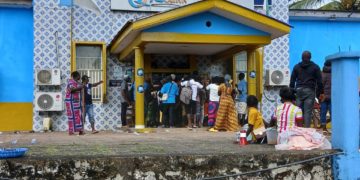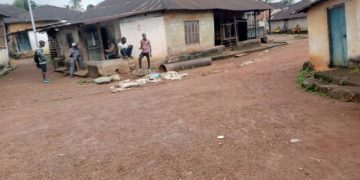By Kemo Cham
The Princess Christian Maternity Hospital (PCMH), Sierra Leone’s main referral center for maternity care, slashed death related to child birth by 11.7 percent in the last six months.
Data from the Ministry of Health shows that the hospital cut down deaths of pregnant women and new mothers from 17 in March to just 2 in September 2024. This was largely attributed to the installation of reliable power supply as part of the government’s hospital electrification programme.
PCMH provides care for an approximate 15,000 patients annually, according to the Ministry, noting that majority of the beneficiaries are pregnant women.
Officials say this is development at PCMH is part of a larger success story in the health sector, which entails a drastic reduction in maternal mortality nationwide.
Sierra Leone, until recently, was among countries with the highest number of maternal and child deaths, a legacy of the country’s civil war which saw its infrastructure destroyed. Reports of babies dying due to power cuts at PCMH and nearby Ola During Children’s Hospital (ODCH) became very common recently as the country struggled a huge deficit of power.
Minister of Health, Dr Austin Demby, said the gains in the investment in the hospital electrification programme is the increase in safe deliveries in the facilities.
“There is a real transformation happening in these facilities and this is evident in the number of safe deliveries and the level of excitement among patients and staff,” Dr Demby said during an inspection ceremony of the solar powered facility at PCMH on Thursday, 5 December, 2024.
“We are very proud of these improvements and we are determined to replicate these success stories in other parts of the country,” the Minister added during the ceremony that was attended by Vice President Dr Mohamed Juldeh Jalloh and a visiting Liberian delegation headed by its Health Minister, Dr. Louise M. Kpoto.
“This solar electrification project is going to change the landscape of our health sector by greatly improving quality of care in these facilities and increasing the wellbeing and survival rates of pregnant women and newborn babies,” said Dr Jalloh.

The hospital electrification programme is a joint initiative by the government and Sustainable Energy For All (SEforALL). Under this three-phased initiative, 17 government hospitals will be provided with critical power from renewable energy.
SEforALL is working with the Canada-Nigerian engineering and technology firm, EM-ONE to install solar microgrids with a total PV capacity of 536.8 kWp & an energy storage capacity of 1.2 MWh. The project is funded by the UK’s Foreign Commonwealth & Development Office (FCDO).
The contract also entailed completion of electrical efficiency retrofits and upgrades to optimize the use of energy within the bebeficiary hospitals.
The solar microgrids were designed with high-quality and durable components from Canadian Solar and Alpha ESS, amongst others. They are equipped with a remote monitoring and control capabilities that enable continuous monitoring of the system’s performance and energy usage.
PCMH is one of six hospitals that make up the second phase of the project. The other beneficiary health facilities in this phase are the ODCH, which shares the same compound with PCMH, Masanga Hospital, Kambia Government Hospital, and Bonthe Government Hospital.
SEforALL is an international organization that works in partnership with the United Nations and leaders in government, the private sector, financial institutions, civil society, and philanthropies to drive faster action towards the achievement of Sustainable Development Goal 7 (SDG7)—access to affordable, reliable, sustainable, and modern energy for all by 2030—in line with the Paris Agreement on climate.
Sierra Leone currently has power capacity of about 100 MW, when it requires 500 MW of interrupted power to serve its citizens. This means only about 27% of the country’s population has access to power.
This situation has dire consequences for healthcare facilities, which need reliable power supply to keep equipment running, store supplies safely, and carry out procedures and to handle emergency cases that occur at night.
A 2018 Service Delivery Indicators (SDI) Health Survey in Sierra Leone show that an estimated 38% of health facilities lack access to electricity. This puts the population at greater risks and compounds the challenges of delivering quality healthcare.
In addition, nearly a thousand health facilities are urgently in need of stable power supply, according to this report. It notes that many continue to run on diesel-powered generators, while others rely on erratic national power grid.
The Health Ministry says hospitals expend 20% of their monthly revenue on fuel alone in order to keep generators running.
Besides the unsustainability of managing running costs, these diesel-powered generators churn out highly toxic hydrocarbon into the atmosphere, contributing to environmental and noise pollution.
In November, the Health Ministry commissioned 25 primary health care facilities with full solar power, providing 24-hour electricity to all of them. They were fitted with over 200 kilowatt peak (kWp) energy supply. That marked the completion of phase two of the government’s ambitious healthcare electrification project launched in October 2022, with the vision of providing health facilities with much needed clean, reliable and sustainable power supply.
The Ministry says the third phase of the project will see an additional 11 government hospitals, including Connaught, Lakka, Port Loko, and Kenema fitted with solar PV and battery systems.
Completion of this project will bring the number of fully solarized government hospitals to 17 with a total of 4.3MWp of full solar power across the country.
Currently, the project has provided 0.6MWp of installed solar PV capacity with battery storage.
“These gains represent the minister’s vision and dedication to ensuring that all of the country’s 1,600 health facilities enjoy unfettered access to reliable, uninterrupted power supply,” the Ministry said in a news release during the inauguration of the 25 primary health facilities.






















